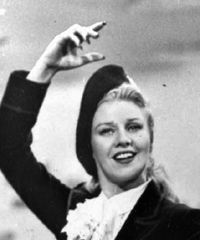She matched Fred Astaire step for step, dancing backward and in high heels through glamorous musicals that provided an escape for Americans mired in the Depression.
Ginger Rogers was 83 when she died Tuesday at her home in Rancho Mirage near Palm Springs, apparently of natural causes.
"She was one of the truly great ladies of the silver screen, she had few equals," Bob Hope said.
Miss Rogers won dance contests in Texas when the Charleston was the rage, launching a career that spanned 65 years, from vaudeville to television. She also proved herself as a singer and actress to a disbelieving studio system.
"She was a genuine, 14-karat gold legend," said actress and dancer Ann Miller, who at age 14 starred with Rogers in the 1937 classic "Stage Door."
Miss Rogers proved herself a dramatic actress with an Oscar for "Kitty Foyle" in 1940, and was the highest-paid woman in Hollywood at one point, starring in hits such as "Lady in the Dark" and "Weekend at the Waldorf." She also exhibited a flair for comedy in "Tom Dick and Harry," "The Major and the Minor" and "Bachelor Mother."
But it was her gliding celluloid partnership with Astaire that made Rogers a legend. They swept through a glittering string of Depression-era musicals that helped Americans forget the emptiness of their wallets and the grumbling in their stomachs.
Astaire was the one in top hat and tails. She was the one in feathered, sequined gowns that trailed across polished floors. Together, they set a standard that remains unmatched today.
Their most notable pairing was in "Top Hat," a 1935 musical featuring Irving Berlin's score. The dance numbers, complete with feathers and arcing kicks that sent Rogers' hem skyward, included "Cheek to Cheek" and "Top Hat, White Tie and Tails."
"She was a dear friend for almost 50 years who delighted millions with her incredible ability to dance and perform," former President Ronald Reagan and his wife, Nancy, said in a statement.
In 1986, Reagan commented: "Her male counterpart got the lion's share of publicity but Ginger Rogers did everything Fred Astaire did and did it with high heels on and did it backwards."
Miss Rogers said her partnership with Astaire, who died in 1987, "turned out to be magic." But it began as pure happenstance, during Broadway rehearsals for "Girl Crazy," a 1930 Gershwin musical.
The producers weren't happy with a routine featuring "Embraceable You." Astaire, then starring on Broadway with his sister Adele, said "Here, Ginger, try it with me." So began their first dance.
"Girl Crazy" established Miss Rogers' stardom as well as her relationship with Astaire, which despite its on-screen incarnation, never included real-life romance. In her 1991 autobiography, Miss Rogers claimed that Astaire's first wife, Phyllis, "didn't want him kissing other women."
"One thing's for sure, (Phyllis) never warmed up to me ... and she surely didn't want her husband to, either," Miss Rogers wrote.
Miss Rogers and Astaire were paired in 10 films. The first was "Flying Down to Rio" in 1933, Astaire's second film and Rogers' 21st.
Their musicals, all but one made for RKO, were: "The Gay Divorcee," "Roberta," "Top Hat," "Follow the Fleet," "Swing Time," "Shall We Dance?" "Carefree" and "The Story of Vernon and Irene Castle."
By 1939, the Astaire-Rogers vogue had run its course and their careers separated. Ten years later, they made one last film together, "The Barkleys of Broadway" for MGM, after Gene Kelly broke his leg and Judy Garland became ill.
"She made such a great contribution to movie dance that we should never forget it," Kelly said in a statement.
Her movie career began in 1930, with a minor role but a memorable line in "Young Man of Manhattan." "Cigarette me, big boy," she said, and the phrase became part of pop culture.
She played Jean Harlow's mother in her last screen role, a 1965 television production of "Harlow." She also performed a nightclub act into her late 70s, until fading health forced her into a wheelchair. Four years ago, she hit the road again to promote her autobiography "Ginger: My Story," and in 1992, she accepted a Kennedy Center Honor for lifetime achievement.
She was born Virginia Katherine McMath on July 16, 1911, in Independence, Mo. Her father abandoned his pregnant wife, Lela. One year later, he kidnaped his daughter. Lela chased him down and got Virginia back.
A cousin called her "Ginja," and it was Ginger thereafter. Later, she took her stepfather's last name for her stage name _ Ginger Rogers.
Miss Rogers was married and divorced five times, and had no children. Her career, and lifelong adherence to Christian Science, seemed everything to her.
"We made happy pictures that people enjoyed seeing," she said in the mid-1960s, "not the kind that audiences have to go through a trauma to see nowadays."


